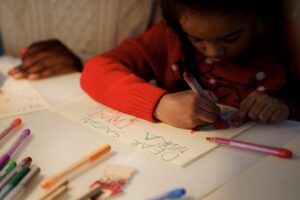Teaching children to hold the pen correctly is one of the most important things that we must pay attention to at the beginning of the child’s educational stage, so that your son can write without many psychological problems, speech disorders, or illegible line…..
Yes, teaching your son to hold the pen in the wrong way may cause speech disorders such as stuttering or psychological disorders, or make the child’s handwriting very bad and illegible, and here comes the famous question and I have a child and I want to teach him to hold the pen correctly, so what are the correct steps for that?!
First of all, we must leave the child the freedom to choose the hand used to write. It is known that a person who uses his right hand to write, the writing center in the brain is in the left part, while for someone who uses his left hand, his writing center is located in the right part. In order to determine which hand the child uses to write, we must put the pen in front of him in the middle (between the right hand and the left hand) and leave him free to pick up the pen without telling him to use his right or left hand.
If we find that the child has grabbed the pen incorrectly, then we can help him by using the hand that is close to him.
We place the palms of our hands above the child’s hand and insert the pen between the index and middle finger, then we use the thumb and hold the three fingers of the child (pinky, ring and middle) so that the pen looks correctly. There are two ways to hold the pen correctly:
The first method: We give the child a coin or a small ball and ask him to put it in the palm of his right hand if he writes with the right or the left if he writes with his left hand and holds it with his pinky and ring fingers or the two little fingers, at this time he has three empty fingers We give him the pen and ask him Holding it, in this case he will have to hold the pen with three fingers without holding it with the two little fingers because they are busy. The child must practice this movement for a week and with time he will get rid of the coin and write properly.
The second method: We wrap a rubber band (elastic) on the wrist of the hand and the pen that the child is holding so that it works for us as a figure (8). This method helps the child to hold on to the pen and not fall from it. You can practice it for your son within a week until he gets used to it without letting the pen slip.
General tips for holding a pen:
• We teach the child to close three fingers, open the thumb and forefinger, then put the pen in the middle and close them gently.
• It is wrong for the child to hold the pen directly with all the fingers of his hands so as not to tire his hands, and also so that he can hold and write.
• It is wrong for a child to press his index finger on the pen, thus it will tire his finger.
• It is good to give a pen to a child at the age of two or a year and a half, so that the mother draws or scribbles in front of him so that he can pick up with his eyes the method of holding the pen and let him scribble and never interfere with holding the hand, because the nerves in his hands are in the formation stage.
Encouraging the child to learn to write:
The child usually needs a long time to learn to write, so we advise parents to be patient in case the child does not make rapid progress and try to enjoy this process. The child can also be encouraged to do this by drawing numbers on a piece of paper in the form of circles, diagonal lines, vertical , horizontal, letting the child trace it, repeating this process in lowercase, writing a paragraph and copying it below, or asking the child questions and letting them answer them and writing the answers on a piece of paper, and having them correct any mistakes in them.
Develop children’s fine motor skills:
The child can be encouraged to develop motor skills through activities that use hands and fingers that strengthen the muscles necessary for the child to have good line later, after tearing strips of paper, picking up objects with plastic tweezers, mixing watercolors with a dropper and other examples of activities that develop different skills In addition to the possibility of communicating with the child’s school to learn about the type of writing that you use to teach children to write, teaching children how to write his name and the names of his family members using them, and encouraging the child to practice writing on a daily basis by setting writing sessions for a few minutes at a time, and not forcing the child To write for a long time to avoid frustration of the child.
Writing stages:
In his book Development and Learning Disorders, Dr. Mel Legian identifies six stages of writing development, including:
- Simulation: (Kindergarten, First).
- Written representation: (from the first to the second).
- Gradual integration and review of what the children wrote.
- Motor ability: It is the child’s ability to use the muscles of the fingers and hands to draw letters easily, clearly and readable, and to hold the writing instrument in a comfortable position.
- Attention: Concentration plays a major role in all stages of writing, as it is a great mental energy, because it is not limited to review, but needs continuous self-follow-up.
- Language: contributes to refining the child’s ability to write, and this is done by recognizing the sounds of letters and understanding words and their meanings.
Parents must also be reminded while teaching their children about the necessity of playing while preparing the son to hold the pen, and the writing pen has a large number of household activities, as it strengthens the child’s muscles and stimulates the process of coordinating his motor abilities in order to write. Colored pencils or pencils are the best tool for a child at the pre-school age, because they create a natural resistance that helps to strengthen the grip, in addition to the need to encourage your son to hold the pencil correctly, and calmly, away from boredom without prolonging the rehearsal session.
In the end, your child’s completed writings should be presented in front of the rest of the family, and a place should be allocated for them inside the house so that the child feels important when he sees his work. This will make him feel applauded and praised and enhance his self-confidence. This is very important, as it helps in the formation of the child’s personality properly, and makes him get used to learning everything new faster.







